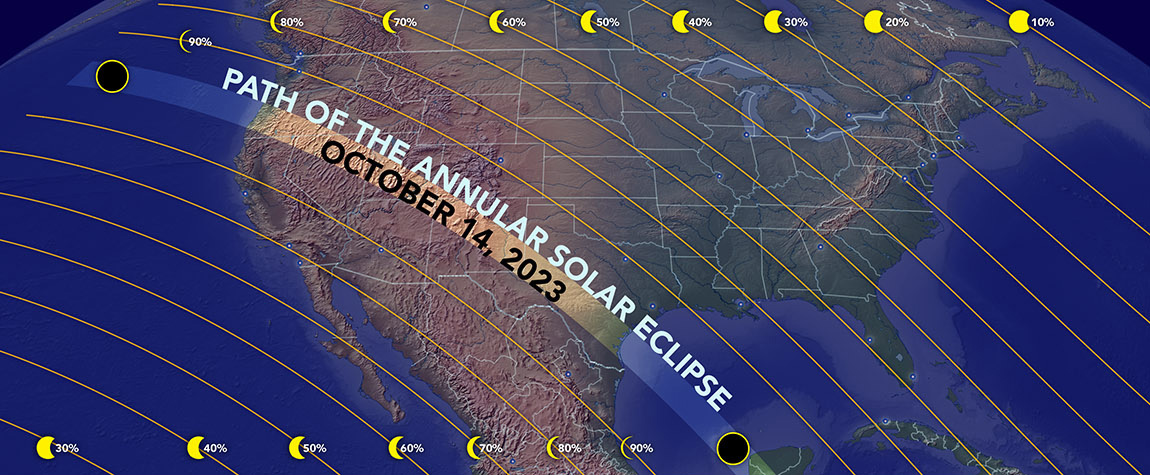
Saturday, October 14, 2023: Mark Your Calendar!
A total solar eclipse crossed the continental United States from coast to coast on August 21, 2017. Some 20 million people saw the Moon completely cover the Sun within a narrow path from Oregon to South Carolina, and hundreds of millions more across all of North America and northern South America saw a partial solar eclipse that day. On October 14, 2023, the Moon will again pass directly between Earth and the Sun — but this time it will not quite completely cover the solar disk, instead turning it into a thin "ring of fire." This annular (Latin for ring-shaped) eclipse will be visible within a roughly 125-mile-wide path from Oregon to Texas and on into Mexico, Central America, and South America. Again, North Americans outside the path will be treated to a partial solar eclipse if the weather cooperates.

As explained in "How & Why Solar Eclipses Happen," by a cosmic coincidence the Sun and the Moon appear nearly the same size in our sky. The Sun's diameter is really about 400 times bigger than the Moon's, but the Sun is also about 400 times farther away than the Moon. Because Earth's orbit around the Sun and the Moon's orbit around Earth are both ellipses, not perfect circles, the apparent sizes of the Sun and Moon vary a little during the year (Sun) and during each month (Moon).
Our planet is closest to the Sun (perihelion) in early January and farthest (aphelion) in early July, and the Sun appears about 3% wider in January than in July (not that you’d notice). When the Moon is closest to Earth (perigee), its apparent diameter is 11% larger than when it’s farthest (apogee); again, this effect is not too noticeable. When near perigee, the Moon can easily cover the entire solar disk and create a total solar eclipse. But near apogee the Moon is too small to cover all of the Sun's brilliant face. At mideclipse an annulus (ring) of brilliant sunlight surrounds the lunar silhouette, resulting in an annular eclipse.
Like the total phase of a total solar eclipse, the annular phase of an annular eclipse is visible only within a narrow path across Earth's surface. Outside that path, observers under clear skies will see a partial eclipse instead. With the path of the October 14, 2023, annular eclipse stretching from Oregon to Texas before heading out into the Gulf of Mexico, where should you plan to rendezvous with the Moon's shadow if you wish to stay in the United States? Most eclipse aficionados go where the weather prospects are most favorable. For this eclipse, as shown in the graphic below, that's parts of Utah, New Mexico, and Texas. (As it turns out, the weather prospects in Mexico's Yucatán peninsula, Central America, and South America are generally less favorable than in the U.S., so staying in the U.S. is a good idea.)

Depending on your location within the path of annularity, the "ring of fire" effect in the U.S. will last up to 5 minutes. Since there will still be plenty of the Sun's bright face showing, it is absolutely essential throughout the entire eclipse to view through a safe solar filter, that is, one that meets the transmission requirements of the ISO 12312-2 international standard. Such filters are widely available and cost at most a few dollars. Looking at the uneclipsed or partially (or annularly) eclipsed Sun through dark sunglasses or any other unapproved filter is a recipe for serious and potentially permanent eye injury. See our Eye Safety and Resources pages for details.

More Information About the Solar Eclipse of October 14, 2023
- Eclipse 2023 on Eclipse2024.org (Dan McGlaun)
- EclipseWise.com (Fred Espenak)
- Eclipsophile.com (Jay Anderson)
- GreatAmericanEclipse.com (Michael Zeiler)
- Interactive Google Map (Xavier Jubier)
- NASA Science
- NationalEclipse.com
- Shadow & Substance (Larry Koehn)
- TimeandDate.com
- How & Why Solar Eclipses Happen
- How to View a Solar Eclipse Safely
- Join Our Email List

